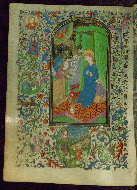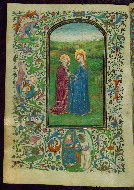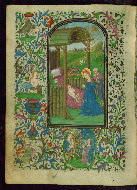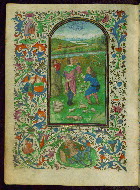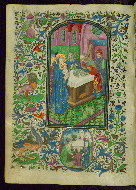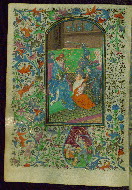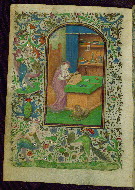Home > Digitized Walters Manuscripts
This document is a tranformation of a TEI P5 XML manuscript description incorporating images. If you have trouble reading special or non-Latin characters on this page, please make sure you have appropriate Unicode fonts installed and an up-to-date web browser.
Walters Ms. W.721, Book of Hours
Browse images (Browse images in a new window) | TEI in XML format
W.721
Book of Hours
This pocket-size Book of Hours was completed for Use of Rome ca. 1450 and was illuminated under the influence of the artists of the Turin-Milan Hours and the Masters of the Gold Scrolls. There are thirteen extant miniatures (inserted), typological border themes, and drolleries. While the extant miniatures exhibit elegance and technical mastery, the figural decoration in the borders is marked in its contrast. However, the collaborating artists seem to have taken a certain amount of delight in the adjoining drolleries. The book itself has seen heavy use, and its original male owner is depicted with an inscribed scroll in the lower border at the first extant illuminated opening on fol. 17r. His image is possibly conflated with that of Lazarus on fol. 35v, and he can be seen depicted in borders throughout the manuscript. The majority of female saints in the litany suggests Franciscan and Francophile sympathies. The Book of Hours features calendar additions that indicate Spanish ownership in the second half of the fifteenth century, and it was rebound in Spain in the nineteenth century.
Ca. 1450 CE
Bruges (?)
Supplied name: Influenced by the Masters of the Gold Scrolls
Supplied name: Influenced by artists of Turin-Milan Hours
Book
Devotional
The primary language in this manuscript is Latin.
Parchment
Finely prepared and well-selected thin to medium-weight parchment; satin-like surface on rectos; thicker parchment used for inserted illuminated folios; back flyleaf i is antique laid paper, pink-splashed marbling on recto matches facing pastedown
Foliation: 296+bis+i
Formula: Because of the condition of this manuscript, the collation formula cannot be confirmed at this time
Comments:
10.7 cm wide by 14.2 cm high
fols. 1r - 297v: 5.0 cm wide by 7.4 cm high
fols. 1r - 12v: 5.0 cm wide by 7.4 cm high
- Columns: 1
- Ruled lines: 16
- Layout cannot be confirmed due to the condition of the manuscript; layout does not apply to calendar or later additions
- Columns: 4
- Ruled lines: 16
- Title: Book of Hours
- Artist: Influenced by the Masters of the Gold Scrolls
- Contents: Because of the condition of the manuscript, many rubrics and incipits could not be determined and/or confirmed
- Hand note: Written in textura
- Decoration note: Thirteen extant miniatures (of an original set of eighteen), inserted; decorated illuminated initials at text openings opposite full-page miniatures, letters in blue or mauve with white tracery (2-5 lines); at secondary text openings, gold on blue and/or mauve, white tracery similar to preceding decorated illuminated initials (2 lines); borders with figural themes at major text openings on versos facing rectos, on four sides; thirty-one narrative themes, thirteen at complete text openings, four at half-extant openings, figures mostly in medallions, one in panel, sometimes free-standing on green plots, infrequent secular motifs; drolleries found at illuminated text openings, motifs generally distributed along outer side margins, themes and gestures usually related to adjacent themes in miniature; secular repertory dominated by figures of men issuing from plants and varied grotesques; both active and impassive actions, music-making, combat, reading, looking on, praying; drolleries of note: a fool with spear (fol. 49v), a woman's horned hairdo (fol. 112r), nude men (fol. 86v-87r), winged hybrid man with conical cap urinating (?) into blossom (fol. 132v, possibly a proverb(?)); rubrics in red; text in black ink
- Title: Calendar
- Rubric: Januarius xxxi luna xxx
- Contents: Calendar one third to one half filled; graded in mauve and dark brown, early additions in ocher; names are generally followed by abbreviated designations; original contents related to Bruges calendar (cf. Plummer 1998), some early additions indicate Spanish ownership (marked *); feasts of note include: Ildephonsus* (Jan. 23, "yllefonsi archepi. tole."), Hyacinth* (Jan. 31, "Jacincti"; irregular date, parallels include GM 2: Hours, Rome use, Flanders, Master of Guillebert de Mets et al., ca. 1450-60), Amandus (Feb. 6), Helen matron* (Feb. 8, "elene matris constantin."), Julian the Hospitaller (Feb. 12, termed martyr instead of confessor), Eulalia* (Feb. 12, "eulalie. lurchie(?)," Barcelona), Eleutherius (Feb. 20), Gertrude (Mar. 18, regularly Mar. 17), Gabriel archangel* (Mar. 18), Columba (Mar. 28, "Columbani virg."; "Columbain" in W.220 on this irregular date, also identified as virgin in GM Ludwig IX 7, Flanders, ca. 1450-60: Plotzek 1982, pp. 115-141) Pastor (Mar. 31, bishop, regularly Mar. 29 or 30), Leo I (Apr. 11, "leoni pape"), "Apollini" (Apr. 20, mr.; rare, extant in W. 244, 263, 279, 220, 190, 438; also GM 2, GM Ludwig IX 7 [see Jan. 31 and Mar. 28], GM Ludwig 8: Bruges, Willem Vrelant, ca. 1460: Plotzek 1982, pp. 143-159), Anastasius I (Apr. 26, "pape," unusual designation; regularly Apr. 27), Peter martyr* (Apr. 29, Dominican, "de ord.e pedi."), Germanus (Apr. 30), Torquatus* (May 1), Brendan (May 17, regularly May 16), Helen matron (May 21, "regine"), Hubert (May 28), Anthony (Jun. 13, "p[res]b[iter]i" instead of confessor, Franciscan; cf. "pb. cf." in W.186), Vitus and Modestus (Jun. 16), Commemoration of St. Benedict (Jul. 11, "despositio . . .," rare; also in W. 220), Virgin of the Snow* (Aug. 4, regularly Aug. 5, this date here occupied by Dominic), Louis of Toulouse (Aug. 19, Franciscan), Louis of France (Aug. 25), Donatian (Aug. 30, Translation), Aegydius (Sept. 1), Adrian (Sept. 7), Guido of Anderlecht (Sept. 11, conf., regularly Sept. 12; a dozen comparisons identified to date include GM 2, öNB 1856, PML M. 285, and W. 220, 190, 438, 440), Remigius (Oct. 1), Benedicta (Oct. 8), Venantius (Oct. 11), Donatian (Oct. 14), Eustace (Nov. 4), Livin (Nov. 11), Machudd (Nov. 15), Facundus* and Primitivus* (Nov. 27, Galacia), Eligius (Dec. 1), Leocadia* (Dec. 9, Toledo), Candida (Dec. 16, "vir.," same designation rather than martyr exemplified in above-cited manuscripts GM 2, Ludwig IX 8, PML M. 285, W. 220) "Sancta maria de la hoo" (Dec. 18, very unusual entry, parallel in Collins Hours, Phila. Mus. of Art 45-65-4, Amiens or Tournai, ca. 1440: Wieck 1988, no. 37)
- Title: Athanasian Creed
- Contents: Ends imperfectly: "Quicumque vult salvus esse. ante amnia opus . . . Ascendit ad celos"
- Title: Hours and Masses for each day of the week, and Devotional Sequence
- Rubric: Die dominica hore de trinitate
- Contents: Texts unabridged; fols. 17r-34v: Sunday Office of the Trinity; fols. 35r-48v: Monday Office of the Dead; fols. 49r-60v: Tuesday Office of the Holy Spirit; fols. 61r-74v: Wednesday Office of All Saints; fols. 75r-85v: Thursday Office of the Sacrament, beginning imperfectly in Terce: "Fregit panem . . . calicens [sic for "calicem"] accipiens benedixit eum . . . ."; fols. 86r-110r: Friday Office of the Cross, headed "Die veneris. hore de sancta cruce . . . ."; fol. 110v: blank, ruled; fols. 111r-125v: Saturday Office of the Virgin, headed "Sabbato. hore de sancta maria . . . ."; fol. 125v, lines 14-16: Prayer to the Virgin, gap in text after opening words: "Oratio ad virginem mariam. Obsecro te domina sancta maria mater dei pieta[te]"; fols. 126r-131r: Mass for forgiveness of sins, headed "Incipiunt missa pro peccatis. Si iniquitates observaveris domine domine quis sustinebit quia . . . ."; fols. 131r-v: Suffrage to St. Sebastian, headed "Memoria de sancto sebastiano. O quam mira refulsit gratia sebastianus martir . . . ."
- Hand note: Full-page miniature on fols. 16r, 49r, 61r, 86r, and 111r
- Title: Hours of the Virign
- Rubric: Hic incipiunt hore beate marie virginis. Secundum consuetudinem romane ecclesie.
- Decoration note: Full-page miniature on fol. 132r
- Title: Advent Office of the Virgin
- Rubric: Incipit officium beate marie secundum usum predictum quod dicitur per totum adventum primo sabbato de adventu ad vesperas.
- Contents: Fols. 200r-208v: Advent Office of the Virgin; fols. 208v-210v: Prayer to the Virgin
- Title: Seven Penitential Psalms
- Rubric: Septem psalmi penitenciales.
- Title: Litany, petitions, and collects
- Rubric: Letania
- Contents: Litany composite of northern French and Flemish saints, Franciscan sympathies indicated (Louis[?], Ivo, Francis, and Clare), majority of female saints; of note is martyr Sebastian (his suffrage is the only one extant); sixteen apostles/evangelists: Peter to Mark; seventeen martyrs, including Sebastian, Thomas (Becket), Livin, Christopher, Quintinus, Adrian, Dionysius, George, Maurice, Nicasius; nineteen doctors/confessors, including Benedict, Louis (of Toulouse?), Ivo, Dominic, Bernard, Donatian, Francis, Leonard, Anthony, Eligius, Aegydius; twenty-two virgins, including Anne, Clare, Gertrude, Avia, Eulalia, Geneviève, Juliana, Fides, Spes, Caritas; fols. 224v-227v: petitions, written consecutively; invocations, Psalm 69, unrubricated prayer on fol. 227r-v beginning, "Saluos fac seruos tuos & ancillas tuas . . . ."; fols. 227v-229v: nine collects, the first headed "or[ati]o," third for bishop specifying ".N." for name: "Deus cui proprium est misereri semiper. . . . Deus qui culpa offenderis penitencia . . . . O. s. d. miserere anime famulo tuo episcopo nostro .N. et dirige eum . . . . Deus a quo sancta desideria recta . . . . Exaudi quesumus domine supplicum preces . . . . Ineffabilem misericordiam tuam domine clementer ostende . . . . Ure igne sancti spiritus renes nostros & cor nostrum . . . . Actiones nostras quesumus domine aspirando preueni . . . . Fidelium deus omnium conditor et redemptor . . . / . . . Benedicamus domino. deo gracias."; fols. 229v-233v: Prayer to God, rhyming, citing divinities and saints in groups as in litany, closing invocation for the dead: "Deus pater qui creasti mundum et illuminasti . . . / . . . Sed requiescant in pace./ amen."
- Title: Office of the Dead
- Rubric: Incipiunt vigilie mortuorum ad vesperas
- Contents: For Use of Rome with customary responses and versicles for lessons 4-5 reversed; fol. 265r: faded marginal annotation in Spanish, below Psalm 50: "Estas lo d ā d. desyr" (?)
- Title: Psalter of St. Jerome, prayer, and closing formulas
- Rubric: Psalterium sancti Iheronimi.
- Incipit: Verba mea auribus percipe domine
- Hand note: Change of scribe on fol. 278r
- Decoration note: Full-page miniature on fol. 277r
- Title: Selection of Seven Verses of St. Gregory
fol. 16v:
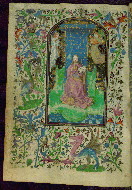
- Title: Salvator mundi
- Form: Full-page miniature
- Text: Offices for Each Day of the Week, Sunday: Trinity
fol. 35v:
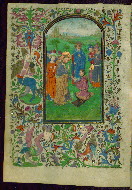
- Title: Raising of Lazarus
- Form: Full-page miniature
- Text: Offices for Each Day of the Week, Monday: Dead
fol. 49v:
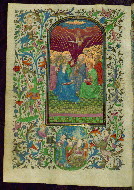
- Title: Pentecost
- Form: Full-page miniature
- Text: Offices for Each Day of the Week, Tuesday: Holy Spirit
fol. 61v:
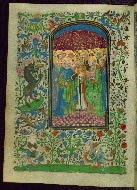
- Title: All Saints
- Form: Full-page miniature
- Text: Offices for Each Day of the Week, Wednesday: All Saints
fol. 86v:
fol. 111v:
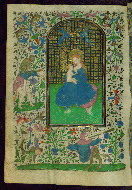
- Title: Virgin of Humility
- Form: Full-page miniature
- Text: Offices for Each Day of the Week, Saturday: Virgin
fol. 132v:
fol. 157v:
fol. 168v:
fol. 173v:
fol. 182v:
fol. 187v:
fol. 277v:
The binding is not original.
Rebound in Spain, ca. nineteenth century; brown calf sewn on four recessed cords; hollow spine with gilt decoration in five compartments, the second compartment contains a Spanish title of gilt letters reading "Oraciones a la virgen"; repairs made by Bentzel in 1935; gilt edges
Bruges(?), ca. 1450, illuminated under the influences of the Turin-Milan Hours and the Masters of the Gold Scrolls
Male owner, depicted with an inscribed scroll on first illuminated text opening (fol. 17r) in lower border; his image possibly conflated with image of Lazarus (fol. 35v); other likely allusions to owner in borders on fols. 17r (with wife?), 112r, 133r, 158r, 173v, 174r, 178r (and wife?), 183r, 187v, 188(?), and 195r
Spanish owner, second half of the fifteenth century (see additions to calendar, faded marginal annotation in Office of the Dead on fol. 265r)
Henry Walters, Baltimore, purchased from unknown source between 1895 and 1931
Walters Art Museum, 1931, by Henry Walters' bequest
Smeyers, M. "A Mid-Fifteenth Century Book of Hours from Bruges in the Walters Art Gallery (MS.721) and Its Relation to the 'Turin-Milan Hours'." Journal of the Walters Art Gallery 46 (1988): 55-76; pp. 56-64, 66-68, figs. 1-15 (fols. 16v-17r, 35v, 49v-50r, 61v, 86v-87r, 111v-112r, 132v-133r, 157v-158r, 168v-169r, 173v-174r, 182v-183r, 187v-188r, 195r, 211r, 277v)
Ainsworth, Maryan W. “Workshop of Jan van Eyck: St. Jerome in His Study.” In Petrus Christus: Renaissance Master of Bruges. Exhibition Catalogue: Metropolitan Museum of Art, 14 April-31 July 1994. Edited by Maryan W. Ainsworth, 68-71. New York: The Metropolitan Museum of Art, 1994; p. 70.
Van Buren, Anne H. “Die Schlußkampagne,” “The Final Campaign,” and “La dernière campagne.” In Heures de Turin-Milan. Edited by Anne van Buren, James H. Marrow, and Silvana Pettenati, 149-161, 342-353, 538-550. Lucerne: Faksimile Verlag, 1996; pp. 161 (n. 41), 353 (n. 41), 550 (n. 41).
Wackers, Paul. Nederlandse litteratuur en cultuur in de middeleeuwen: Verraders en Bruggenbouwers: Verkenningen naar de relatie tussen Latinitas en Middelnederlandse letterkunde. Vol. 15. Amsterdam: Prometheus. 1996, cover (fol. 277v).
Panofsky, Erwin. Peinture et dévotion en Europe du Nord: à la fin du Moyen âge. Paris: Flammarion. 1997, p. 95, fig. 65 (fol. 277v).
Spantigati, Carlenrica, Joseph J. Rishel, and Carl Brandon Strehlke. Jan Van Eyck (1390 c. - 1441) Opere a confronto. Torino: Umberto Allemandi & C.. 1997, p. 58, cat. no. 37 (fol. 277v).
Hall, Edwin. "The Detroit Saint Jerome in Search of Its Painter." Bulletin of the Detroit Institute of Arts 72, nos. 1/2 (1998): 10-37, p. 15, fig. 5 (fol. 277v).
Osano, Shigetoshi. The Detroit "St. Jerome in His Study" Reconsidered in the History of a Saint's Image Making, Reception and Collecting. Image and Text: Studies in Western Art 1 (1999), p. 9 (fol. 277v).
Smeyers, Maurits. Flemish Miniatures from the 8th to the Mid-16th Century: The Medieval World on Parchment. Turnhout: Brepols, 1999; pp. 262, 263, 285.
Baert, Barbara. “La Piscine Probatique à Jérusalem: Une source thérapeutique dans les textes et les images médiévaux.” In "Als Ich Can": Liber Amicorum in Memory of Professor Dr. Maurits Smeyers. Edited by Bert Cardon, Jan Van der Stock, and Dominique Vanwijnsberghe, 91-130, vol. 1. Leuven: Peeters Press, 2002; p. 116.
Noel, William. "Books in the Home: Psalters and Books of Hours." In Medieval Mastery: Book Illumination from Charlemagne to Charles the Bold (800-1475). Edited by William Noel and Lee Preedy, 56-67. Turnhout: Brepols, 2002; p. 67 (fig. 14).
Baert, Barbara. A Heritage of Holy Wood: The Legend of the True Cross in Text and Image. Leiden: Brill, 2004; p. 277.
Büttner, F.O. “Sehen—verstehen—erleben. Besondere Redaktion narrativer Ikonographie im Studengebetuch.” In Images of Cult and Devotion: Function and Reception of Christian Images in Medieval and Post Medieval Europe. Edited by Søren Kaspersen and Ulla Haastrup, 89-148. Copenhagen: Museum Tusculanum Press, 2004; pp. 136, 146.
Bousmanne, Bernard, and Thierry Delcourt, eds. Miniatures flamandes, 1404-1482. Belgium: Bibliothèque royale de Belgique, 2011, p. 171.
Principal cataloger: Randall, Lilian M.C.
Cataloger: Herbold, Rebekah
Editor: Herbert, Lynley
Copy editor: Wallace, Susan
Conservators: Owen, Linda; Quandt, Abigail
Contributors: Emery, Doug; Noel, William; Ransom, Allison; Tabritha, Ariel; Toth, Michael B.; Wiegand, Kimber
The Walters Art Museum
Licensed for use under Creative Commons Attribution-ShareAlike 3.0 Unported Access Rights, http://creativecommons.org/licenses/by-sa/3.0/legalcode. It is requested that copies of any published articles based on the information in this data set be sent to the curator of manuscripts, The Walters Art Museum, 600 North Charles Street, Baltimore MD 21201.

